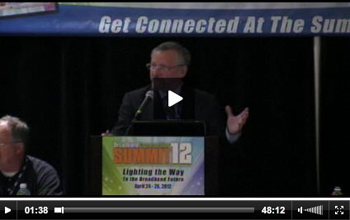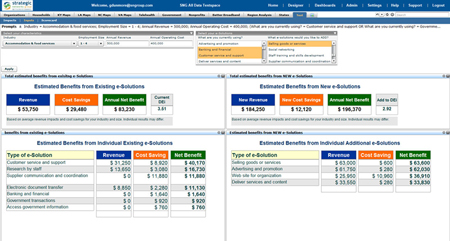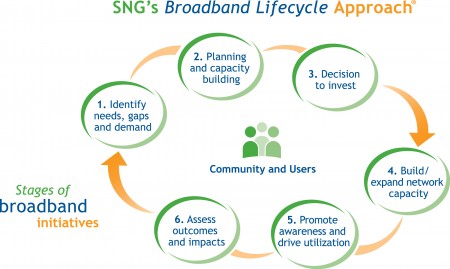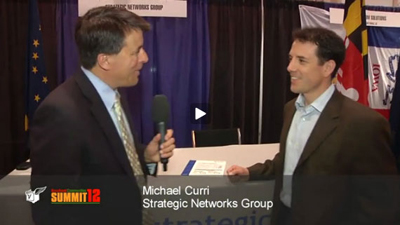Broadband Program Management… What’s the Best Way?
by Michael Curri
When administering a new program to deploy broadband and stimulate adoption, governments traditionally ramp-up their internal resources or hire consultants.
But there’s an alternative – a model that leverages existing local resources and links with local stakeholders who have a vested interest in the project outcome of economic development through broadband.
T  he downsides for the traditional models are apparent. Ramping-up internal staff requires hiring and getting everyone up to speed on how to administer the program. And once the program ends, the staff you worked so hard to find and train will leave. Bad enough that you lose good people you’ve invested in, but staff may be looking for a job during their time with you, looking for a better deal to move on to a permanent position. If this happens, you’re left to restart – and you lose ‘history’ before projects have been completed before they take-on their new job.
he downsides for the traditional models are apparent. Ramping-up internal staff requires hiring and getting everyone up to speed on how to administer the program. And once the program ends, the staff you worked so hard to find and train will leave. Bad enough that you lose good people you’ve invested in, but staff may be looking for a job during their time with you, looking for a better deal to move on to a permanent position. If this happens, you’re left to restart – and you lose ‘history’ before projects have been completed before they take-on their new job.
Continue Reading →
After spending a few days in both Dallas and Washington DC over the past month, it is apparent that the biggest challenge facing broadband projects in every U.S. region is sustainability, and key to that of course is utilization.
As projects are finishing building their broadband infrastructure, now more than ever is the time for SNG to help meet the challenges of going from build to use.
Unfortunately, we have heard from way too many regions who tell us their adoption rates are low and the networks are not – and will not be – sustainable without major uptake.
Low adoption rates (i.e. 20%) cannot sustain the ongoing operations of a broadband network where the business case requires 40-50% uptake.
As your needs increase to drive uptake, please make sure you reach out to SNG as we have introduced some So they’re now beginning to focus on how to increase adoption rates and they’re realizing that they need to drive utilization with end-users – our focus and strength as we’ve again demonstrated with the new DEi Calculator.
Larry Strickling, NTIA
The Honorable Lawrence E. Strickling, Assistant Secretary of Commerce, Administrator, National Telecommunications and Information Administration (NTIA) gave the keynote address at the Broadband Summit, he summed up the U.S. governments « what’s next » in 5 steps…
1) Remain dedicated to make sure grantees complete projects on time and on budget.
2) Finding opportunities to expand projects where build savings can be leveraged.
3) Conduct a multi-year evaluation program in place to measure ROI and inform future decisions
4) Use the recently passed legislation to enact a national public safety broadband network to help reach even more rural areas with broadband
5) Upon completion of grants, deploy the NTIA team to drive access in America.
James Salter, AEG
Chairman of Atlantic Engineering Group (AEG), James Salter was extremely entertaining as he looked both backward and forward.
Salter had both praise and criticism for the stimulus program. Kudos for recognizing that rural broadband is “basic infrastructure” and concern for the amount of time it has taken to get things approved and moving – a natural problem given the resources available to administer this massive task.
So the question he examined was – now what… when it comes to rural broadband?
Salter compares the need for further government involvement and investment, much like we saw in the 1930’s, driving electricity to homes everywhere.
And he sees the capacity to fund only one network in rural America – it does not matter who does it. His argument was that it is not profitable or possible to have more than one carrier survive in a competitive environment. The pure math is that there is not a big enough pie for carriers to be fighting over customers – and whatever network provides “triple play” services (TV, broadband and phone) also needs to be robust enough to serve all of the community’s broadband needs.
Once again, Jim Baller and broadbandus.tv did great work broadcasting many sessions from the Broadband Summit. If you haven’t already, we would encourage you to visit the site… it does require a one-time registration. Michael Curri moderated a jam-pack  ed session examining the challenges of transitioning from build mode to utilization.
ed session examining the challenges of transitioning from build mode to utilization.
Winning Strategies for the Emerging Knowledge Economy included panelists Bruce Abraham (North Georgia Network), Donny Smith (Jaguar Communications), Kyle Hollifield (Bristol Virginia Utilities), and Betty Zeman (Cedar Falls Utilities).
For a copy of the PowerPoint from this session, click here.
SNG Unveils DEi Calculator in Dallas
We were thrilled to receive rave reviews with the introduction of our DEi Calculator in Dallas.
Businesses, organizations, and individuals can use the DEi calculator as a companion to the Digital Economy index (DEi) Scorecard, both designed to help them understand how to embrace new technologies and business practices, and leverage e-solution  s to grow and enhance their opportunties.
s to grow and enhance their opportunties.
SNG’s Digital Economy index (DEi) Scorecard and online DEi Impact Calculator gives end-users the power and insights of years of SNG’s broadband research. Users can quickly identify ways to be more effective, productive, and competitive by leveraging broadband by comparing themselves against tens of thousands of their peers in SNG’s database.
The DEi Scorecard and DEi Impact Calculator are an excellent solution to help drive utilization of e-solutions, of utmost interest to:
- Carriers looking for new subscribers or current subscribers to upgrade to fiber
- Economic development agencies looking to give their constituents a roadmap to maintain and grow their business using broadband
- Broadband project managers looking to drive uptake and use of their ultra-fast broadband network
Regions and economic development agencies are excited about the possibility of putting this tool in the hands of their constituents, helping them understand… How does a local business compare to the competition? What are other organizations doing better to leverage broadband? What are the benefits of broadband that individuals should be leveraging? Learn More>>
The Question « What’s Next? » Dominates Broadband Summit
by Doug Adams
This year’s preeminent question for most attendees at the Broadband Summit in Dallas seemed to be « What’s Next? »
 With builds nearing completion, many American States are in the throes of step 4 of the broadband lifecycle, left to wonder… what do we do now? How do we drive adoption? And at SNG we’d add…how do we turn adoption into utilization?
With builds nearing completion, many American States are in the throes of step 4 of the broadband lifecycle, left to wonder… what do we do now? How do we drive adoption? And at SNG we’d add…how do we turn adoption into utilization?
So along the lifecycle, many regions in the U.S. have gotten the « supply side » of broadband down (building the network).

In an interview on the conference floor, Michael Curri explains the importance of the "demand side" of broadband... and how SNG can help.
SNG is not only thrilled to be asked to participate in this year’s Broadband Communities Summit in Dallas from April 24th through April 26th, but we’re also able to offer our Bandwidth Subscribers a 2/3 off discount to the event. This offer is good only for those who have not already registered and the code can be transferred to your colleagues. Register here, click the first radio button for VIP Code Holders, then enter the code SNGVIP300 for a discounted full pass.

Stop by and see Doug Adams and Michael Curri at our booth and see a demo of DEAP – the industry’s first and only hands-on, comparative database. Digital Economy Analytics Platform (DEAP) from SNG enables our clients to compare regions and industries to uncover actionable information and insights. With this new solution, regional leaders can leverage the best practices from each region and industry across their territory. Learn More>>
On April 24th at 4:10, Michael Curri will be moderating a panel entitled Winning Strategies for the Emerging Knowledge Economy. And on April 26th at 10:30, Michael will be on the panel for Alternative Rural Futures: Emerging Opportunities.
Look for live blogs on the SNG site from the Summit and a recap in April’s Bandwidth.
SNG and its partners in Illinois are employing our industry-leading broadband utilization survey to build a foundation of understanding, from which we will develop broadband infrastructure planning and programs. Good data is at the heart of all good decision-making and planning as it provides insights for all that’s required to truly leverage broadband as a transformative regional initiative.
 It speaks to just how important Illinois sees broadband expansion and upgrades as part of their future that Illinois Lt. Governor Sheila Simon has taken a leadership position with the survey project recently deployed by Broadband Illinois/Partnership for a Connected Illinois. Drawing on SNG’s vast store of knowledge already acquired through similar work across the U.S., a team comprised of members of state agencies, universities, and SNG has been assembled. This team is undertaking an outreach communications program which has identified thousands of community organizations statewide and engaged dozens of Community Anchor Institutions to help “get the word out.”
It speaks to just how important Illinois sees broadband expansion and upgrades as part of their future that Illinois Lt. Governor Sheila Simon has taken a leadership position with the survey project recently deployed by Broadband Illinois/Partnership for a Connected Illinois. Drawing on SNG’s vast store of knowledge already acquired through similar work across the U.S., a team comprised of members of state agencies, universities, and SNG has been assembled. This team is undertaking an outreach communications program which has identified thousands of community organizations statewide and engaged dozens of Community Anchor Institutions to help “get the word out.”
Thousands of households and organizations have already submitted their responses. Broadband Illinois is so enthusiastic about the potential engendered by the household and organizations data they’ve extended response time and expanded sponsorship of participation to several other state agencies.
It’s thanks to these extensive efforts that participation rates are on the rise.
Even a Tech Firm Finds it Hard to Drive e-Solutions
by Doug Adams
The other day I was speaking with a colleague who is the Director of Marketing for a Tech Firm. This is a company filled with what most would consider “early adopters” and tech enthusiasts. In other words, a group of individuals who embrace broadband and e-solutions every day, in a myriad of ways.
 She was struggling with a decision of when to roll out a new e-solution to her sales team. It’s an online database/prospecting tool that provides invaluable information about the company’s prospects. She knows it is a great investment… a tool that will help her sales team grow their individual account base – and drive corporate sales… but, she is hesitant.
She was struggling with a decision of when to roll out a new e-solution to her sales team. It’s an online database/prospecting tool that provides invaluable information about the company’s prospects. She knows it is a great investment… a tool that will help her sales team grow their individual account base – and drive corporate sales… but, she is hesitant.
You see, my colleague is a pragmatist. While her company is a tech firm, sales people are notoriously tech laggards… and very slow to change their routine. Getting them to change or adopt new behaviors can be tough, and right now she’s fighting the uphill battle of getting them all connected – and using – a new CRM program.
So she’s resisting the internal pressure (and the pressure from her friendly sales person) to adopt this technology right now because, in her words, “I only get one chance to launch this, and I need to get it right… otherwise no one will use it.”
Whether she realizes it or not, she’s preaching the SNG story – adoption is great… utilization is what really matters.
And so she has a plan to come as close as she can to ensuring success. She will roll out this new solution after CRM has been adopted. She will provide this prospecting tool in a month where sales opportunities are down and sales people are more open to creative ways to find opportunities. And she will assign a few champions on the sales team to communicate the benefits and convey success stories.
While regions and communities chase expanding broadband availability and bridging the digital divide, we could learn a lot from my friend… make sure you have a strategy to drive utilization. Change can be seen as scary and daunting… line up the pieces and players in a manner that is most likely to produce utilization. SNG can help. Find out how we can provide you with that plan, a roadmap for each organization in your region, and champions to show the way to realize broadband’s transformative economic impacts.
by John de Ridder
 In the never ending quest for the “killer apps” that drive the uptake of broadband, one that we seem to have overlooked is digitization – which I’d call the ‘killer enabler’ of applications that undermines traditional carrier and regulatory models.
In the never ending quest for the “killer apps” that drive the uptake of broadband, one that we seem to have overlooked is digitization – which I’d call the ‘killer enabler’ of applications that undermines traditional carrier and regulatory models.
The following are some key insights on how digitization has changed the rules of the telecommunications industry. The impact the roll-out of broadband networks has had on key stakeholders is detailed in my update of the regulatory tool-kit for infoDev and the International Telecommunication Union (ITU) [1].
Digitization
Networks used to be built vertically around specific applications (e.g. voice or PayTV) but digitization ‘de-layers’ networks so that content or applications are no longer network specific. Next Generation Networks can support all applications over a single all-IP data network.
As data protocols are application agnostic, they create a problem for traditional operator business models which use applications and content services (e.g. calls) to subsidise carriage (i.e. the line rental or mobile handset). Digitization separates carriage and content services allowing ‘over-the-top’ (OTT) content and application services (e.g. Skype and Netflix).
Broadband
As policy makers and regulators focus on getting more broadband, there has been a shift in access policy. Traditionally, the focus has been on opening legacy copper networks to competition from new entrants. Unsurprisingly, incumbents complained that cost-based access-pricing was too low. They claimed this made them reluctant to invest in fibre access networks to improve broadband services. That made it a policy issue.
There is no clear best practice yet. It is too early to say which approaches work best and how country-specific circumstances might affect outcomes. Some countries have allowed ‘regulatory holidays’ so that the terms of access are determined commercially (e.g. USA). Many countries are determined to see ‘open access’ carried forward from copper to fibre networks; especially when they are supported by public investment.
Open access on fibre does not allow the same unbundling options that are available on copper networks (e.g. full or partial line-sharing). With the few exceptions where point-to-point fibre is deployed, the most common form of access will be bitstream.
Broadband networks displace switched interconnection with IP interconnection which makes the regulator’s task lighter because the access bottle-neck is removed.
Access Pricing
Access pricing for fibre based fixed access networks poses a dilemma for regulators. If they apply traditional cost based approaches to the large investments made in pushing fibre deeper into access networks, regulated prices will hinder the migration of customers from existing copper-based networks, which are largely written-down. Again, there is no clear best-practice on how to adapt existing costing methods and manage the transition.
Of course, with digitization service providers can go ‘over the top’ to deliver content and services to end customers. IP interconnection will be sufficient [2].
IP interconnection has existed in the internet system for many years with no regulation of ‘peering and transit’ arrangements. Many of these are similar to the ‘bill and keep’ (also known as ‘sender-keeps-all’) arrangements that apply to Receiving Party Network Pays mobile regimes; so for RPNP the transition is simple. For the more common situation in mobile and fixed networks, the transition is helped where termination rates are low. Again, the regulator’s task should become easier; once transitional issues are resolved.
The switched PSTN model is dying and there is divergence in regulatory approaches to the emerging world of next generation networks. Many regulators (rightly) hesitate to act too swiftly as whatever they do will shape the market. Operators of broadband networks will have to move swiftly to shift their business models towards charging for traffic.
End Notes
[1] Digitization is a key theme in the update of Module 2 (Competition and Pricing) of the infoDev/ITU tool kit for regulators at http://www.infodev.org/en/Publication.1140.html
[2] Control of the access line was important when carriage and content were joint in supply and demand; but with de-layering any provider can supply content and application services. However, bitstream access may confer a quality advantage in delivering managed services (e.g. IPTV) relative to over-the-top ‘best efforts’ content and applications (e.g. internet television).
 he downsides for the traditional models are apparent. Ramping-up internal staff requires hiring and getting everyone up to speed on how to administer the program. And once the program ends, the staff you worked so hard to find and train will leave. Bad enough that you lose good people you’ve invested in, but staff may be looking for a job during their time with you, looking for a better deal to move on to a permanent position. If this happens, you’re left to restart – and you lose ‘history’ before projects have been completed before they take-on their new job.
he downsides for the traditional models are apparent. Ramping-up internal staff requires hiring and getting everyone up to speed on how to administer the program. And once the program ends, the staff you worked so hard to find and train will leave. Bad enough that you lose good people you’ve invested in, but staff may be looking for a job during their time with you, looking for a better deal to move on to a permanent position. If this happens, you’re left to restart – and you lose ‘history’ before projects have been completed before they take-on their new job.





 She was struggling with a decision of when to roll out a new e-solution to her sales team. It’s an online database/prospecting tool that provides invaluable information about the company’s prospects. She knows it is a great investment… a tool that will help her sales team grow their individual account base – and drive corporate sales… but, she is hesitant.
She was struggling with a decision of when to roll out a new e-solution to her sales team. It’s an online database/prospecting tool that provides invaluable information about the company’s prospects. She knows it is a great investment… a tool that will help her sales team grow their individual account base – and drive corporate sales… but, she is hesitant. In the never ending quest for the “killer apps” that drive the uptake of broadband, one that we seem to have overlooked is digitization – which I’d call the ‘killer enabler’ of applications that undermines traditional carrier and regulatory models.
In the never ending quest for the “killer apps” that drive the uptake of broadband, one that we seem to have overlooked is digitization – which I’d call the ‘killer enabler’ of applications that undermines traditional carrier and regulatory models.

